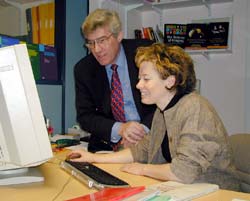Mammoth project reveals frozen secrets

Jerry Cowhig, Managing Director of Institute of Physics Publishing and Professor Kathy Sykes, Collier chair of public engagement of science and engineering at Bristol University, are searching the online IOP Journal Archive. Every journal article published by the Institute of Physics since 1874 is now available to subscribers
Which way does a mammoth skeleton point in Siberia? No, it’s not a Christmas cracker joke. To find the answer you have to look in a rather surprising place – the Institute of Physics’ new online archive.
In an article published in the first edition of Proceedings of the Physical Society in 1874, John Rae writes about the physical properties of ice and mammoth remains. He put forward a theory as to why so many of the mammoth skeletons found near the Yenesei river in Siberia had been found with their heads pointing southwards. He said that if these mammoths died in or near the river, their bodies would get swept down the river to the shallow area near the mouth. The mammoth’s head, weighed down by its tusks and skull, would drag along the bottom and in shallow water the body would still float with the current – in a similar way to a boat pulling on an anchor. When the river froze in winter, the mammoths would become frozen in this position – with their heads pointing southwards with the flow. As this river flows from south to north, the heads would be pointing southwards when they froze.
This fascinating article can be accessed for the first time on the World Wide Web on the IOP Journal Archive. Every journal article published by the Institute of Physics since 1874 is now available to subscribers – that is over 500 volume-years of journals, over 100,000 articles and over one million pages of scientific research.
“This was a massive project, and it will significantly benefit research in physics and maintains our long tradition of innovation in electronic publishing,” said Jerry Cowhig, Managing Director of Institute of Physics Publishing.
Articles by many pioneering physicists can be found in the archive, including some by William and Lawrence Bragg. This father and son team shared a Nobel Prize for their work on x-ray crystallography, which was the method used in the discovery of the structure of DNA.
“This is a great resource for anyone with an interest in physics or its history. You can read original articles by physicists like Schrödinger, who you usually only read about in text books,” said Professor Kathy Sykes, Collier chair of public engagement of science and engineering at Bristol University.
Non-subscribers can search the archive, and view the abstracts of the papers. To access the full paper, a paid subscription is needed.
Media Contact
All latest news from the category: Physics and Astronomy
This area deals with the fundamental laws and building blocks of nature and how they interact, the properties and the behavior of matter, and research into space and time and their structures.
innovations-report provides in-depth reports and articles on subjects such as astrophysics, laser technologies, nuclear, quantum, particle and solid-state physics, nanotechnologies, planetary research and findings (Mars, Venus) and developments related to the Hubble Telescope.
Newest articles

Innovative 3D printed scaffolds offer new hope for bone healing
Researchers at the Institute for Bioengineering of Catalonia have developed novel 3D printed PLA-CaP scaffolds that promote blood vessel formation, ensuring better healing and regeneration of bone tissue. Bone is…

The surprising role of gut infection in Alzheimer’s disease
ASU- and Banner Alzheimer’s Institute-led study implicates link between a common virus and the disease, which travels from the gut to the brain and may be a target for antiviral…

Molecular gardening: New enzymes discovered for protein modification pruning
How deubiquitinases USP53 and USP54 cleave long polyubiquitin chains and how the former is linked to liver disease in children. Deubiquitinases (DUBs) are enzymes used by cells to trim protein…


